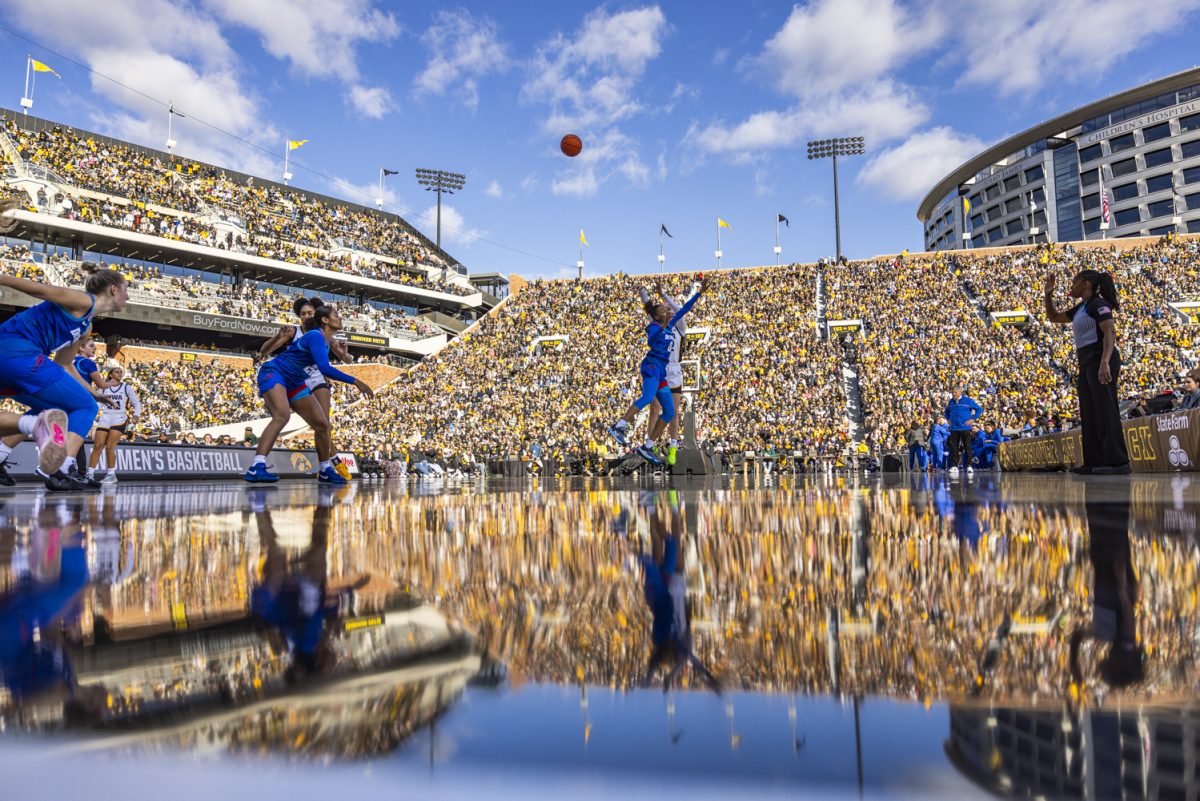Imagine throwing on your uniform, lacing up brand-new Nikes, and getting ready to play 40 minutes of gritty, hard-nosed collegiate basketball against one of the top teams in the country. You step out of the locker room and begin running onto the floor when a slight breeze hits the back of your neck as your sneakers squeak on the hardwood.
You turn to the crowd, expecting to see thousands of dedicated fans lining the arena to watch your squad warm up. But instead, you find that more than 5,000 sailors are staring at you from makeshift grandstands constructed on the deck of an aircraft carrier in the middle of the San Diego Bay.
For many, this might seem like a fever dream, but for former Gonzaga center Drew Timmie, it was once a reality as he and his teammates took on Big Ten basketball powerhouse Michigan State aboard for the USS Abraham Lincoln for the 2022 “Carrier Classic.”
The game, brought back after a 10-year hiatus, was a success for the West Coast Conference kings as the Bulldogs took down the Spartans 64-63 in a tight early season bout.
However, the real winner of the contest proved to be the entire college basketball community and the concept of unorthodox or unconventional venues serving as unique opportunities to expose the public to sports and games that might otherwise never get the coverage they deserve.
Unique and unconventional sports venues have been around for decades, with events like boxing matches, Final Four tournaments, and NHL Winter Classics all being held in nontraditional spaces for their respective sports. However, in this day and age, nontraditional sports, or those with less media coverage, should continue to embrace the use of random venues to drive ticket sales and engagement.
A perfect example of how this can affect a team came in 2004 when a series of WNBA games were famously played at Radio City Music Hall. The unconventional venue for basketball hosted six New York Liberty home games, as well as the annual WNBA All-Stars vs. Team USA matchup.
The site was chosen as an alternative to Madison Square Garden because James Dolan, owner of the arena, had rented it out in late august to the Republican National Convention.
Despite Dolan’s decision being yet another case of subtle sexism in American sports, the opportunity to play in such an unorthodox space allowed the games to become instant classics at a time when women’s basketball wasn’t the juggernaut it is now.
Tamika Catchings was even quoted as saying that she felt like the team was finally getting the exposure they deserved, stating, “We are the show,” after first walking out onto the makeshift backstage court just hours before tipoff.
This use of an unconventional venue further provided exposure to a league that had struggled to support itself for years. While it didn’t have the lasting effects owners had hoped for, it was a powerful reminder of the potential of clever marketing and the desire to be part of unique sporting experiences.
This success also helped the team sell out Arthur Ashe Stadium in 2008, with a crowd of more than 19,000. The famous venue, which plays host to the U.S. Open, became the site of a critical milestone for both the Liberty and the WNBA. It was the league’s first outdoor game and one of the Liberty’s first sellouts.
This same formula was used to help Iowa Women’s basketball in the now-famous “Crossover at Kinnick” game last October, where the Hawkeyes defeated DePaul in a preseason matchup that witnessed over 55,000 fans to historic Kinnick Stadium.
The record-setting showcase of Caitlin Clarke, Kate Martin, and the rest of the future national runners-up was a defining moment in women’s athletics, illustrating how far women’s basketball has come and the power of unconventional sports venues to shift public perception and engagement.
Although the event was historic, “Crossover at Kinnick” wasn’t the first time an Iowa program used the football venue to facilitate a record-setting matchup. Back in 2015, Iowa wrestling took on Oklahoma State in the “Grapple on the Gridiron,” a spectacle that brought a record of more than 42,000 spectators to Kinnick Stadium to witness history between two of the most storied programs in collegiate wrestling.
The event, capped off by an 18-16 Hawkeye victory, saw the two programs duke it out on a chilly 53-degree November day. The success of this event even led to a recreation of the dual meet seven years later at Globe Life field in the “Bout at the Ballpark.”
These examples are just a few of the many ways leagues and programs have been able to provide much-needed exposure to specific athletic events, especially when public interest is low for a particular sport.
If more programs and teams leaned into the idea of promoting their sport through nontraditional sports venues, we would likely see a jump in interest, regardless of the sport or team, due to the spectacle of the event. This would ultimately benefit the entire sporting community and make media deals and brand exposure more equitable for all.



